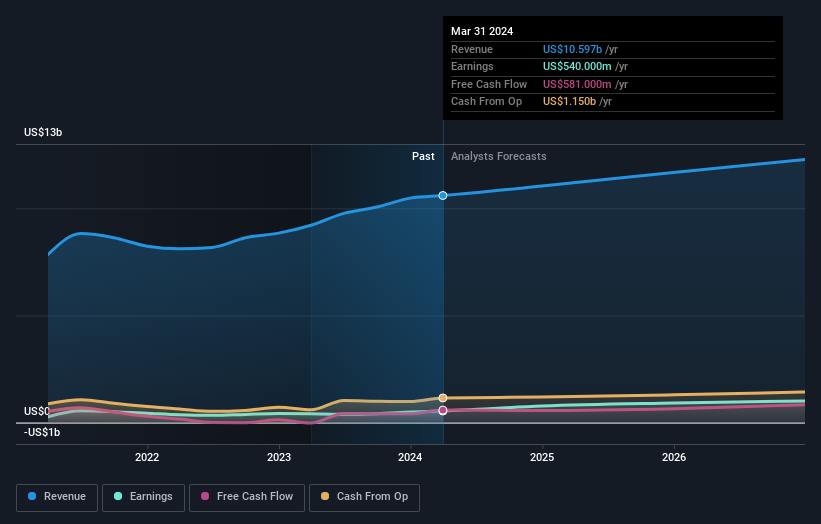Autoliv, Inc. (NYSE:ALV) defied analyst predictions to release its first-quarter results, which were ahead of market expectations. The company beat expectations with revenues of US$2.6b arriving 2.1% ahead of forecasts. Statutory earnings per share (EPS) were US$1.52, 5.5% ahead of estimates. The analysts typically update their forecasts at each earnings report, and we can judge from their estimates whether their view of the company has changed or if there are any new concerns to be aware of. We’ve gathered the most recent statutory forecasts to see whether the analysts have changed their earnings models, following these results.
View our latest analysis for Autoliv
Following the latest results, Autoliv’s 22 analysts are now forecasting revenues of US$11.0b in 2024. This would be an okay 4.2% improvement in revenue compared to the last 12 months. Per-share earnings are expected to surge 45% to US$9.61. In the lead-up to this report, the analysts had been modelling revenues of US$11.0b and earnings per share (EPS) of US$9.52 in 2024. So it’s pretty clear that, although the analysts have updated their estimates, there’s been no major change in expectations for the business following the latest results.
The analysts reconfirmed their price target of US$131, showing that the business is executing well and in line with expectations. That’s not the only conclusion we can draw from this data however, as some investors also like to consider the spread in estimates when evaluating analyst price targets. There are some variant perceptions on Autoliv, with the most bullish analyst valuing it at US$155 and the most bearish at US$102 per share. As you can see, analysts are not all in agreement on the stock’s future, but the range of estimates is still reasonably narrow, which could suggest that the outcome is not totally unpredictable.
Of course, another way to look at these forecasts is to place them into context against the industry itself. The period to the end of 2024 brings more of the same, according to the analysts, with revenue forecast to display 5.6% growth on an annualised basis. That is in line with its 4.8% annual growth over the past five years. By contrast, our data suggests that other companies (with analyst coverage) in a similar industry are forecast to see their revenues grow 11% per year. So although Autoliv is expected to maintain its revenue growth rate, it’s forecast to grow slower than the wider industry.
The Bottom Line
The most obvious conclusion is that there’s been no major change in the business’ prospects in recent times, with the analysts holding their earnings forecasts steady, in line with previous estimates. On the plus side, there were no major changes to revenue estimates; although forecasts imply they will perform worse than the wider industry. There was no real change to the consensus price target, suggesting that the intrinsic value of the business has not undergone any major changes with the latest estimates.
With that in mind, we wouldn’t be too quick to come to a conclusion on Autoliv. Long-term earnings power is much more important than next year’s profits. We have forecasts for Autoliv going out to 2026, and you can see them free on our platform here.
Don’t forget that there may still be risks. For instance, we’ve identified 3 warning signs for Autoliv that you should be aware of.
Have feedback on this article? Concerned about the content? Get in touch with us directly. Alternatively, email editorial-team (at) simplywallst.com.
This article by Simply Wall St is general in nature. We provide commentary based on historical data and analyst forecasts only using an unbiased methodology and our articles are not intended to be financial advice. It does not constitute a recommendation to buy or sell any stock, and does not take account of your objectives, or your financial situation. We aim to bring you long-term focused analysis driven by fundamental data. Note that our analysis may not factor in the latest price-sensitive company announcements or qualitative material. Simply Wall St has no position in any stocks mentioned.
